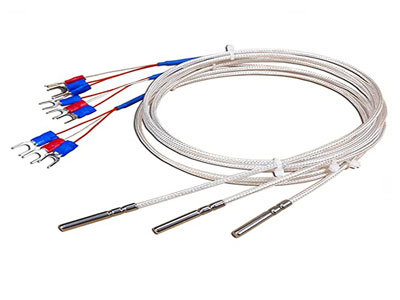How Is PT100 Calculated?
Key Takeaway
To calculate the PT100 sensor’s resistance, use its temperature coefficient (Alpha, α). The formula is:
α=R100−R0R0×100alpha = frac{R_{100} – R_0}{R_0 times 100}α=R0×100R100−R0
Here, R100R_{100}R100 is the resistance at 100°C, and R0R_0R0 is the resistance at 0°C, which is 100 ohms for a PT100 sensor. The standard temperature coefficient for PT100 is 0.003851/°C.
For example, if you have a PT100 sensor, the resistance at 100°C is typically 138.51 ohms. This makes it easy to calculate temperature changes based on resistance. This coefficient ensures the sensor provides accurate temperature readings across a range of conditions.
Basics of PT100 Calculation
The PT100 sensor is a type of resistance temperature detector (RTD) that uses platinum to measure temperature. The “PT” in PT100 stands for platinum, and “100” indicates that the sensor has a resistance of 100 ohms at 0°C. PT100 sensors are highly regarded for their precision, stability, and broad temperature range, typically from -200°C to +850°C. These characteristics make PT100 sensors suitable for a wide variety of industrial applications, such as in chemical processing, food production, and HVAC systems. Understanding how to calculate PT100 values is crucial for engineers, as it allows them to accurately measure and control temperatures in critical processes. This involves using the temperature-resistance relationship inherent in platinum to derive precise temperature readings from resistance measurements.

Temperature-Resistance Relationship
The temperature-resistance relationship in PT100 sensors is linear and predictable, which is why platinum is used. As the temperature increases, the resistance of the platinum element also increases. This relationship is characterized by a temperature coefficient, which for platinum is approximately 0.00385 ohms per degree Celsius. This coefficient allows engineers to calculate the resistance of the PT100 sensor at any given temperature.
For instance, at 0°C, the resistance of a PT100 sensor is exactly 100 ohms. At 100°C, the resistance increases to about 138.5 ohms. This linear relationship simplifies the calculation process and ensures high accuracy in temperature measurement. The predictable nature of this relationship is essential for creating reliable and consistent temperature control systems in various industrial applications.
Understanding this linear relationship is fundamental for anyone involved in temperature measurement and control. The consistency and predictability of the platinum element’s behavior make PT100 sensors highly reliable for applications where precise temperature readings are necessary.
Formula for PT100 Calculation
The basic formula for calculating the resistance RtR_tRt of a PT100 sensor at a given temperature ttt is:
Rt=R0×(1+α×t)R_t = R_0 times (1 + alpha times t)Rt=R0×(1+α×t)
where:
• RtR_tRt is the resistance at temperature ttt,
• R0R_0R0 is the resistance at 0°C (100 ohms for a PT100 sensor),
• αalphaα is the temperature coefficient (0.00385 per °C),
• ttt is the temperature in Celsius.
For example, to find the resistance at 50°C:
R50=100×(1+0.00385×50)R_{50} = 100 times (1 + 0.00385 times 50)R50=100×(1+0.00385×50) R50=100×(1+0.1925)R_{50} = 100 times (1 + 0.1925)R50=100×(1+0.1925) R50=100×1.1925R_{50} = 100 times 1.1925R50=100×1.1925 R50=119.25 ohmsR_{50} = 119.25 , text{ohms}R50=119.25ohms
This formula provides a straightforward method to determine the resistance at any given temperature, ensuring precise temperature monitoring and control. By applying this formula, engineers can convert resistance measurements into accurate temperature readings, facilitating better control and decision-making in various industrial processes.
Using this formula helps maintain the accuracy and reliability of the PT100 sensors. It is essential for engineers to understand and apply this calculation method to ensure the sensors’ optimal performance and the overall efficiency of the temperature control systems.
Practical Examples
Let’s apply the formula in practical scenarios. Suppose you are working in a chemical plant where maintaining a specific temperature is crucial for a reaction. You have a PT100 sensor installed, and you need to ensure the temperature remains at 75°C. Using the formula:
R75=100×(1+0.00385×75)R_{75} = 100 times (1 + 0.00385 times 75)R75=100×(1+0.00385×75) R75=100×1.28875R_{75} = 100 times 1.28875R75=100×1.28875 R75=128.875 ohmsR_{75} = 128.875 , text{ohms}R75=128.875ohms
You can set your control system to maintain this resistance, ensuring the reaction proceeds at the correct temperature.
In another example, in a food processing facility, the PT100 sensor might be used to monitor and control the temperature of a pasteurization process. Accurate temperature control is vital for ensuring food safety and quality. By knowing the resistance values at specific temperatures, engineers can calibrate their systems to maintain the desired conditions precisely.
Tools for Accurate Calculation
To achieve accurate PT100 calculations, various tools and software are available. These tools help simplify the process and ensure high precision:
RTD Calculator Tools: Online calculators can quickly compute resistance values for PT100 sensors at different temperatures, eliminating manual calculation errors.
Temperature Controllers: Modern temperature controllers often come with built-in algorithms for RTD inputs, including PT100 sensors. These controllers automatically calculate and adjust based on real-time resistance measurements.
Calibration Equipment: High-precision calibration instruments can measure and adjust the sensor’s resistance, ensuring it provides accurate readings.
Simulation Software: Software like MATLAB or LabVIEW can simulate the temperature-resistance relationship, allowing engineers to design and test control systems virtually before implementation.
Using these tools, engineers can ensure their PT100 sensors are calibrated accurately and functioning correctly, leading to more reliable temperature control in various applications.
Conclusion
Calculating PT100 values is a fundamental skill for engineers involved in temperature measurement and control. By understanding the temperature-resistance relationship and applying the correct formulas, precise temperature monitoring and control can be achieved. Utilizing tools and software further enhances accuracy, ensuring optimal performance in industrial processes. Mastering PT100 calculations ensures that engineers can maintain the desired conditions, enhance product quality, and ensure safety across various applications. This knowledge is indispensable for anyone working in environments where temperature control is critical.

